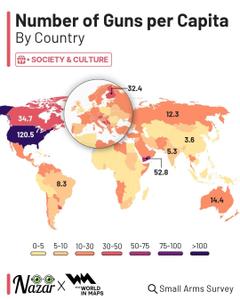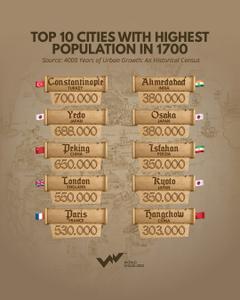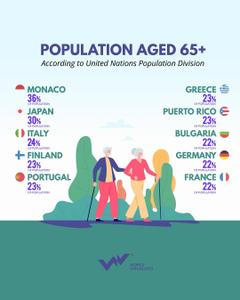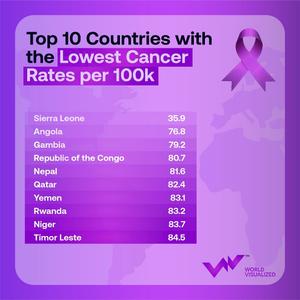statistics

World / 2 weeks ago
What the world’s gun-per-capita map really shows
The global map of civilian firearm ownership reveals that a few nations hold the overwhelming majority of the world’s guns. According to the Small Arms Survey, civilians possessed an estimated 857 million firearms globally as of 2024, representing roughly 85% of all small arms in circulation.

Environment / 22 weeks ago
Suicide rates in Italian regions revealed
According to Statista, the Aosta Valley—a small region in northwestern Italy—reported the highest suicide rate in the country, at 15.3 per 100,000 people. This figure is more than four times higher than rates observed in some southern regions. Here’s a snapshot of some key findings:

Maps / 26 weeks ago
Tenerife outshines Brazil in tourism despite being 0.02% its size
According to a 2024 statistic, the tiny Spanish island of Tenerife welcomed a whopping 7.2 million tourists, surpassing Brazil, a country 4,200 times larger, which attracted 6.6 million visitors during the same period. This jaw-dropping contrast begs the question about what makes Tenerife such a tourist magnet. Despite boasting world wonders like the Amazon Rainforest, Iguazu Falls, Christ the Redeemer, and over 7,400 kilometres of coastline, Brazil struggles to fully capitalise on its tourism potential. In contrast, Tenerife, the largest of Spain’s Canary Islands, located off the northwest coast of Africa, thrives as a top global destination.

World / 37 weeks ago
Southeast Asia’s Powerhouses: Indonesia, Singapore, Vietnam, others set for strong growth
Indonesia is set to lead the Southeast Asian region with a projected economy of $1.5 trillion, positioning itself as a major economic powerhouse, according to IMF. This growth is fuelled by the country’s rich natural resources, including palm oil, coal, and nickel, making it a key global supplier. Indonesia’s rapidly expanding middle class drives domestic consumption, further strengthening the economy. With ongoing infrastructure development and digital transformation, the country is expected to maintain its upward trajectory in the coming years.

Culture / 38 weeks ago
How much lovers spend on Valentine's Day gifts
Valentine's Day is celebrated in many countries around the world, with people showering their loved ones with gifts, flowers, and romantic gestures. But how much do people spend on Valentine's Day gifts in different countries? According to a 2021 report by Statista, here's a breakdown of the average Valentine's Day gift spending per person in the top countries:

World / 39 weeks ago
How cities have transformed over time – And what’s next for urban growth
Cities have always been in flux, shaped by trade, industry, and geopolitics. From ancient commercial hubs to modern megacities, urban centres have expanded and adapted in response to economic and technological changes. But what forces have driven these shifts, and what can we expect in the future? Data revealed that the 19th and 20th centuries saw one of the most significant transformations in urban history. The rise of industrialisation fuelled large-scale migration to cities, as people sought jobs in factories and emerging industries. Urban populations surged, and cities like Manchester, New York, and Shanghai expanded rapidly, becoming economic powerhouses. Colonial influence also played a key role, as trade networks and administrative centres grew, shifting global economic power toward industrialized nations.

World / 41 weeks ago
Global aging crisis: The growing impact of a rapidly aging population
By 2050, an estimated 16% of the global population will be aged 65 or older, doubling the share recorded in 2022, according to the United Nations Population Division. This dramatic demographic shift reshapes societies worldwide, with Monaco leading the way. In the tiny European principality, 36% of the population is aged 65 or older, the highest proportion globally. Japan, a nation already grappling with the challenges of an ageing society, follows closely behind at 30%. The country’s ageing demographic has sparked critical conversations about the sustainability of its healthcare and welfare systems as policymakers scramble to address the needs of its older citizens.

Technology / 45 weeks ago




